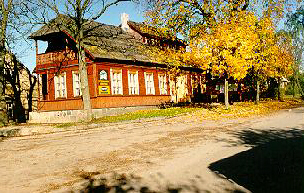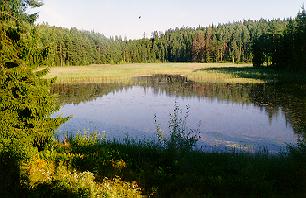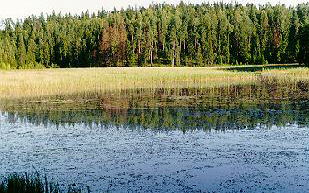


- play sports games near summer hotels; on play grounds, gymnasium in Plokstines hostel(football, etc.);
- ride a horse, go by water bikes, windsurfings and yachts. You can hire these things in the yacht-club in Plateliai;
 - hike and take part in tourist trips by cars, bicycles and
riding the horses, too. All information is available in the
Park; the rent of tourist implements - in Plateliai,
Plokstines hostel, Zemaiciu Kalvarija;
- hike and take part in tourist trips by cars, bicycles and
riding the horses, too. All information is available in the
Park; the rent of tourist implements - in Plateliai,
Plokstines hostel, Zemaiciu Kalvarija;
- fish. You can get a permission in the administrative centre, at the hostel, campings and try your luck;
- hunt. If you want to go for hunting, you must pay the tax, get a permission from the hunting centre;
- visit museums of traditional woodcarved sculptures in Godeliai, Babrungenai, church art in Berzoras, literature museum in Bukante, Sarnele, historical sites in Plateliai, Zemaiciu Kalvarija;
- go on excursions, where you`ll be able to gain some expierence about the wild nature life, historical and ethnic culture of Samogitia, visit museums, architecturical, natural, fine art, arheological monuments, etc;
 - take part in Samogitia Festivals and Rites: a the beginning
of summer - folk art festival; the festival of Rasa (is on
the 22-23d of June; at the beginning of Jule there is a
Church festival in Zemaiciu Kalvarija (thousands of people
come here and pray, sing ancient Church songs and visit
chapels, which were built 350 years ago) and a swimming
competition across the Plateliai lake (3 km); Shrove - tide
carnival in February.
- take part in Samogitia Festivals and Rites: a the beginning
of summer - folk art festival; the festival of Rasa (is on
the 22-23d of June; at the beginning of Jule there is a
Church festival in Zemaiciu Kalvarija (thousands of people
come here and pray, sing ancient Church songs and visit
chapels, which were built 350 years ago) and a swimming
competition across the Plateliai lake (3 km); Shrove - tide
carnival in February.
 The park is divided into 90 territorial zones, the further
development of which is organized according to the project.
The park is divided into 90 territorial zones, the further
development of which is organized according to the project.These zones fall into 12 groups: 1 - Nature reserve (Urwald). 2 -Urban reserve of Zemaiciu Kalvarija. 3 - Nature partial reserves. 4 - Cultural reserves. 5 - Preserved areas of cultural values. 6 - Recreational summer home area. 7 - Rural recreation area. 8 - Green recreational area. 9 - Agroparks. 10 - Settlements. 11 - Protected forest area. 12 - Agricultural area.
 The relief of the national park was formed by the glaciers some 10-12
thousand years ago. There you can find a great variety of hills,
valleys and lowlands of different origin. Several hills rise over
150-200 m above sea level, and they cover the greatest part of the
national park. Because of big amaunt of precipitation, hollows,
formed by glacier, turned into lakes and marshes. The lakes cover
more than 7% of the territory. The biggest is the Plateliai Lake
(1205 ha, 47 m depth). In the area of the park one can find 20 more
smaller lakes.
Elks, Red - deers, Roes, Wild - boars, european and
mountain Hares, Lynxes, Wolfes, Foxes, Badgers, Raccon Dogs, Martens,
Squirels, Otters, Beavers, American Minks and little rodents are
common in the forests of ZNP. There are about 163 species of birds,
23 of them are migratory birds. 134 species of birds nest in the
park. There are some rare birds: Black-throuted Diver, Peregrine
Falcon, Osprey, Red-breasted Merganser, Montague`s Harrier, Curlew,
Tengmlms Owl, Black Stork, Black Grouse. Perches, roaches, breams,
pikes, tenches, crusian carps live in the lakes. There are some kinds
of rare salmon fishes (Coregonus lavaretus holstatus Thienemams
platelensis, Coregonus albula L.), eel and other fishes. In some
rivers and lakes you can find crawfishes. Fir groves (spruce, pine)
dominate in the Park. But you can see oak - woods among them. There
are rather large areas of berries - bilberries, cranberries, bog
whortleberries and so on.
The relief of the national park was formed by the glaciers some 10-12
thousand years ago. There you can find a great variety of hills,
valleys and lowlands of different origin. Several hills rise over
150-200 m above sea level, and they cover the greatest part of the
national park. Because of big amaunt of precipitation, hollows,
formed by glacier, turned into lakes and marshes. The lakes cover
more than 7% of the territory. The biggest is the Plateliai Lake
(1205 ha, 47 m depth). In the area of the park one can find 20 more
smaller lakes.
Elks, Red - deers, Roes, Wild - boars, european and
mountain Hares, Lynxes, Wolfes, Foxes, Badgers, Raccon Dogs, Martens,
Squirels, Otters, Beavers, American Minks and little rodents are
common in the forests of ZNP. There are about 163 species of birds,
23 of them are migratory birds. 134 species of birds nest in the
park. There are some rare birds: Black-throuted Diver, Peregrine
Falcon, Osprey, Red-breasted Merganser, Montague`s Harrier, Curlew,
Tengmlms Owl, Black Stork, Black Grouse. Perches, roaches, breams,
pikes, tenches, crusian carps live in the lakes. There are some kinds
of rare salmon fishes (Coregonus lavaretus holstatus Thienemams
platelensis, Coregonus albula L.), eel and other fishes. In some
rivers and lakes you can find crawfishes. Fir groves (spruce, pine)
dominate in the Park. But you can see oak - woods among them. There
are rather large areas of berries - bilberries, cranberries, bog
whortleberries and so on.
 The Zemaitija National Park contains many agricultural territories
with a great amount of unique monuments, reflecting ethnocultural
heritage of the very early population up to our days. There live
Zemaiciai (Samogitian`s), making a separate ethnic and cultural group
of Lithuanian nation, with peculiar dialect, traditions,
characteristic features, original architecture.
The Zemaitija National Park contains many agricultural territories
with a great amount of unique monuments, reflecting ethnocultural
heritage of the very early population up to our days. There live
Zemaiciai (Samogitian`s), making a separate ethnic and cultural group
of Lithuanian nation, with peculiar dialect, traditions,
characteristic features, original architecture.In the ZNP there are 30 arheological monuments (stone century camps, mounds, old cemeteries castle hills, sacred hills), 29 architectural and 60 monuments of fine art (crosses, chapels, sculptures, paintings), as well as several urban and natural monuments. Especially interesting are Samogitian crosses and wayside shrines, which are built near the roads, synthesis of pagan worship and Chirstianity. Of big value are old wooden Samogitian farm houses. Almost 100 of them were built at the end of 19th century or at the beginning of the 20th and they maintain the features of the century.
